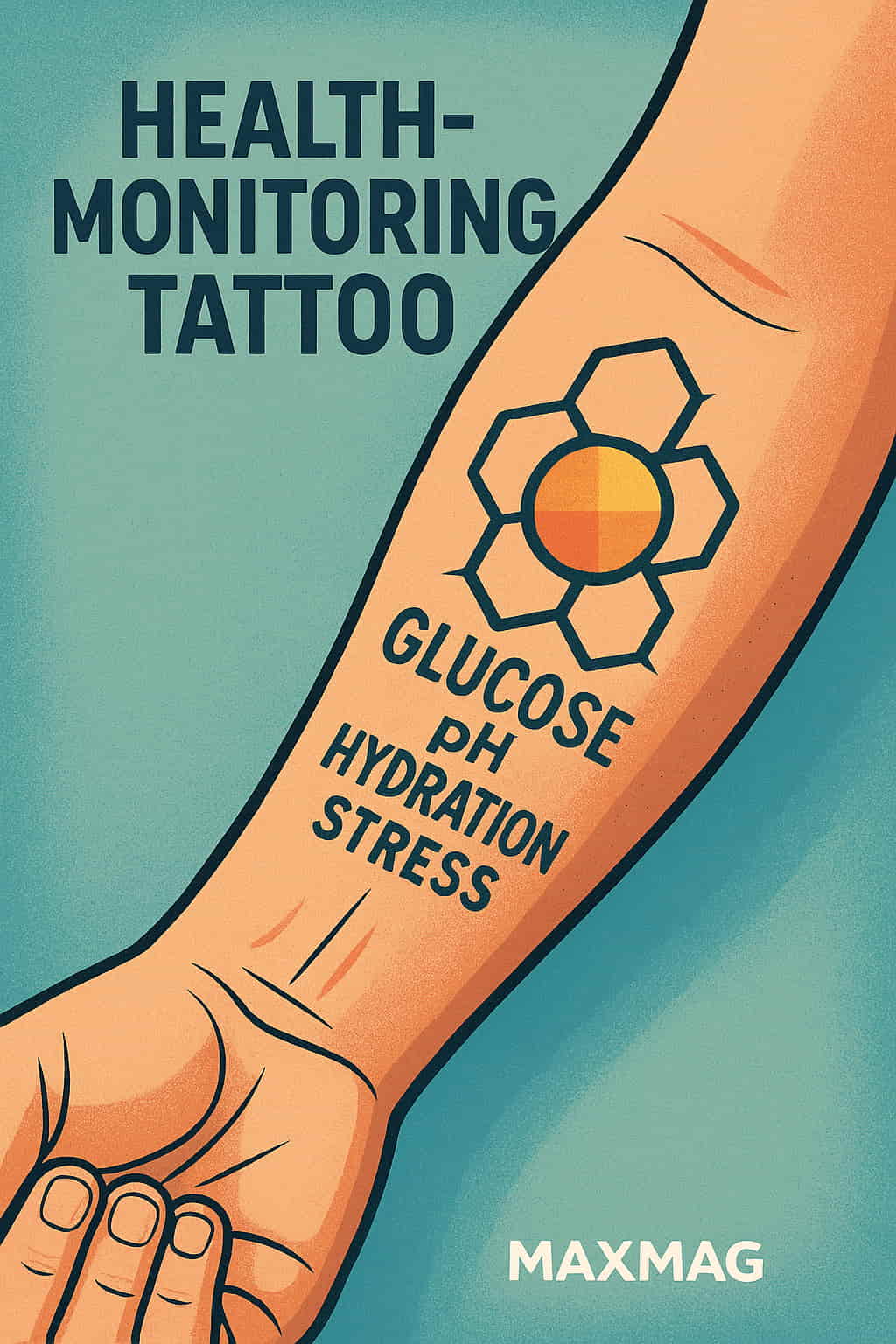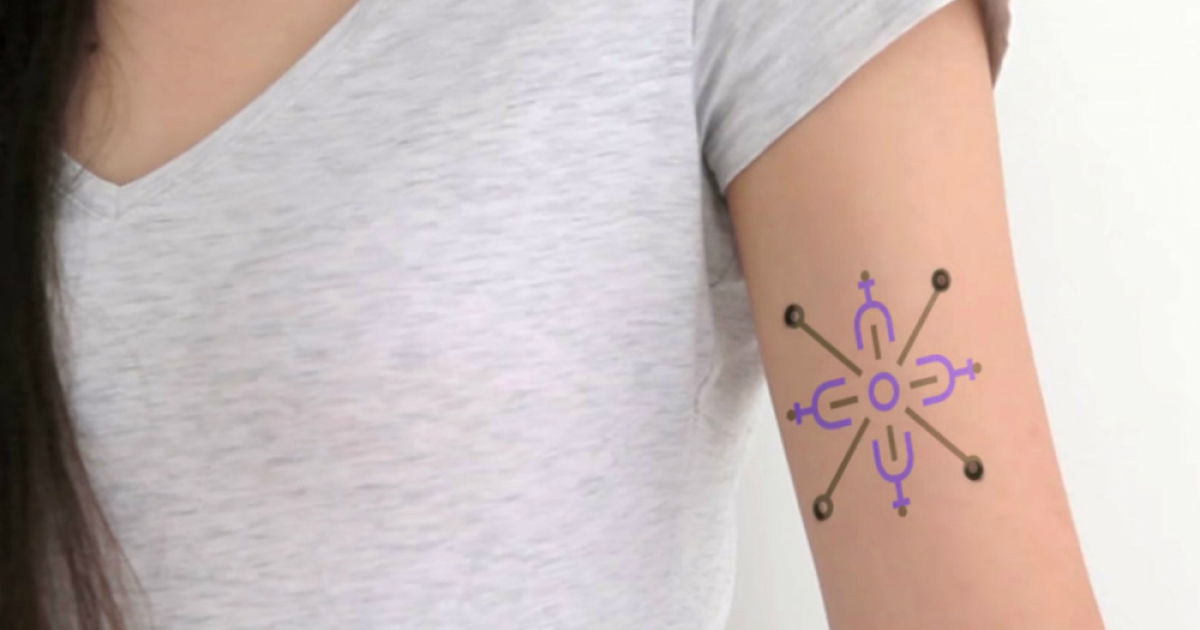
Imagine if your skin could alert you when something inside your body goes wrong. Not through an app or wearable device, but through a subtle shift in the color of a tattoo. That’s no longer science fiction—it’s an emerging technology that merges body art with real-time health data. The health-monitoring tattoo is not just about aesthetics; it’s about turning your skin into a smart health sensor.
This groundbreaking approach blends biochemistry, wearable tech, and personalized medicine to offer a completely new way of monitoring health—right under your skin.
Turning Tattoos into Health Sensors
Unlike traditional tattoos that are purely decorative, these new designs use specialized inks that react to physiological changes. These inks are created using compounds that can detect changes in glucose levels, pH balance, hydration status, or even stress-related hormones like cortisol. When those internal conditions shift, so does the ink’s color—giving a visual cue that your body is undergoing a change.
This technology opens new possibilities for those managing chronic illnesses. For example, people living with diabetes could potentially monitor their glucose levels visually without using needles or external devices. According to a recent update from the National Institute of Biomedical Imaging and Bioengineering, researchers are actively exploring how skin-interfacing biosensors could revolutionize disease tracking.
How a Health-Monitoring Tattoo Works
The science behind these tattoos is rooted in chemistry and physiology. The ink is infused with biosensitive compounds that interact with body fluids like sweat or interstitial fluid. These biological reactions trigger a visible response—usually a color shift—making it possible to “see” changes that previously required blood samples or digital meters.
For instance, if your hydration drops, a tattoo designed to detect pH could fade or turn a different hue. If your glucose level rises too high, a glucose-reactive ink might shift from blue to green. All this happens continuously and passively, providing instant feedback on your internal state.
At institutions like Stanford University, early-stage trials have already demonstrated that biosensitive tattoos can react consistently under lab-controlled conditions. Now the focus is shifting to real-world environments and long-term reliability.
Who Can Benefit from These Tattoos?
While anyone interested in health optimization might find them appealing, the most immediate impact is likely to be among people with chronic health conditions. Here’s how various groups could benefit:
-
Diabetics could track glucose fluctuations in real time.
-
Athletes might monitor dehydration before symptoms appear.
-
Patients in remote areas could gain health insights without frequent lab visits.
-
People under chronic stress could detect hormone surges early.
In high-demand professions, like the military or space travel, where constant health assessments are crucial, these tattoos could offer life-saving insights with zero equipment.
Real-Life Applications Are Getting Closer
Some of the earliest research in this area was done using pigskin and hydrogel-based sensors. While initial tests were promising, the challenge has been making the sensors long-lasting and stable under real-world conditions. Researchers at MIT recently released findings on a hydrogel-based tattoo sensor that maintained functionality for several days even in fluctuating humidity and temperature—marking a significant step toward practical use.
Moreover, companies in the biotech sector are developing prototypes that could pair with smartphone cameras. Imagine taking a photo of your tattoo, and an app tells you what your blood sugar or hydration level is. This would dramatically reduce the need for finger sticks or expensive wearables.
Health-Monitoring Tattoo
The term health-monitoring tattoo refers to this entire class of bio-interactive body art. Unlike patches or implants, these tattoos are semi-permanent and can last for weeks or even months. They require no batteries, no charging, and no external device to work—making them especially appealing for users who want low-maintenance health support.
However, there are still several hurdles to overcome. Safety is a key concern. The U.S. Food and Drug Administration (FDA), which regulates medical devices, will need to evaluate these inks to ensure they are non-toxic and hypoallergenic. Biocompatibility testing is underway in multiple labs, but no tattoo of this type has yet received regulatory approval for clinical use.
That said, private funding in this space is growing. Venture-backed startups in Boston and San Francisco are exploring commercial partnerships, and academic institutions are hosting hackathons to crowdsource new ink formulations.
How These Tattoos Compare to Traditional Devices
To understand their potential, it helps to compare health-monitoring tattoos to other common monitoring systems. Conventional devices, like continuous glucose monitors (CGMs), rely on sensors inserted under the skin and synced with apps. While effective, these devices are often bulky and expensive.
Health-monitoring tattoos, in contrast, are:
-
Low-profile: Once applied, they don’t protrude or require a receiver.
-
Maintenance-free: No calibration or charging.
-
Stylish: Designs can be personalized like any regular tattoo.
-
Accessible: Lower production costs could make them widely affordable.
This isn’t just about convenience—it’s about offering more inclusive health technology. A single parent working multiple jobs might not be able to afford high-tech gadgets, but a safe, color-changing tattoo could provide critical health information affordably and discreetly.
Ethical and Practical Questions
While the concept is exciting, it’s not without ethical dilemmas. If a health tattoo reveals a user’s condition through visible changes, could that lead to discrimination or unwanted attention? And what happens to the data if these tattoos are integrated with apps that track changes over time?
The American Medical Association has weighed in on similar issues, urging developers to prioritize user privacy and informed consent. It’s also crucial that any app-based component clearly states how data will be used and stored.
Another issue is permanence. While these tattoos aren’t designed to last forever, they’re not easily removable either. If a user’s health changes or if a better sensor becomes available, will they be stuck with outdated ink? Developers are exploring biodegradable or photo-fading inks to address this concern.
The Road Ahead: Personalized Wellness on Your Skin
We’re still at the early stages of this innovation, but the momentum is undeniable. Scientists are working on inks that can detect multiple markers simultaneously, like blood oxygen and hydration. Others are exploring tattoo interfaces that change not only color but also texture or glow under UV light.
One particularly promising development involves pairing tattoos with augmented reality glasses. A wearable lens could read your tattoo and project visual overlays—like traffic light-style alerts—based on your current health metrics. This could be transformative for people with cognitive impairments who struggle to interpret raw data.
Research groups like those at the University of California, Berkeley, are already exploring multisensor tattoo systems with promising early results. Their findings suggest that the future of wearable health may not be wearable at all—it may simply be part of us.
Realistic Use Case
Let’s say you’re a long-distance cyclist. You get a health-monitoring tattoo on your upper arm that changes from light blue to dark purple as your hydration levels drop. Mid-ride, you notice the shade darken. That visual cue prompts you to hydrate before dehydration sets in.
This kind of real-time, non-invasive feedback can prevent injuries, improve performance, and even save lives—all without interrupting your routine.
Final Thoughts
The health-monitoring tattoo isn’t just a novelty—it’s a potential game-changer. It offers a way to literally wear your health on your sleeve, transforming your body into an early-warning system. While regulatory, safety, and ethical questions remain, the underlying science is strong and advancing rapidly.
We may be witnessing the dawn of a new medical frontier—one where your body doesn’t just signal illness through symptoms, but through art. And in that future, your skin may be more than just a canvas; it could be your most loyal health ally.
FAQ
What is a health-monitoring tattoo?
It’s a tattoo made with biosensitive ink that reacts to changes in your body’s chemistry, offering real-time health information through color changes.
Are these tattoos approved for medical use?
Not yet. They’re still in the research phase and have not received regulatory clearance from agencies like the FDA.
How long do these tattoos last?
They’re semi-permanent—lasting from several weeks to a few months, depending on skin type and ink formulation.
Can they replace traditional devices like glucose monitors?
They might complement or even replace them in some cases, especially for continuous tracking, but more testing is needed.
Are they safe?
Preliminary studies show promise, but long-term safety evaluations are still underway.






